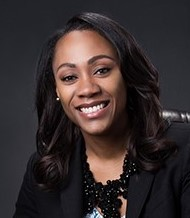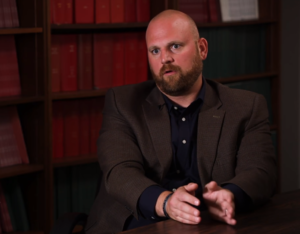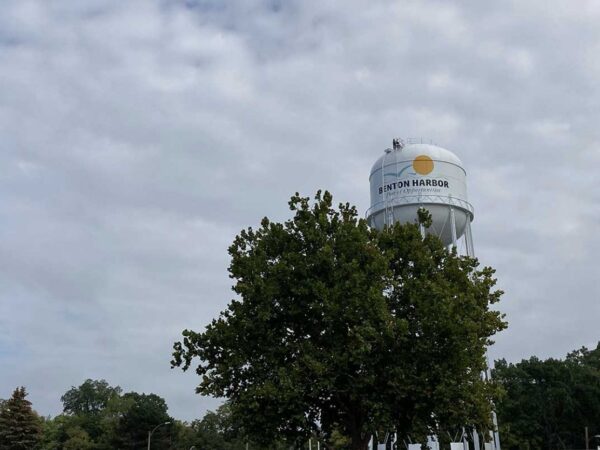
Less than a year into their first year in office, two Great Lakes region elected officials are making good on their pledges for water rights and advocacy.
“Residents’ concerns about drinking water will no longer fall on deaf ears,” said Michigan Gov. Gretchen Whitmer in her 2018 election campaign.
She promised to create a public advocacy position that will “investigate any complaint from the public” and have direct access to the governor.

Ninah Sasy, Clean Water Public Advocate, Photo courtesy of Michigan EGLE via Gary Wilson
Making good on her campaign pledge, Whitmer recently appointed Ninah Sasy to be the clean water public advocate in Michigan’s Department of Environment, Great Lakes and Energy.
The action takes steps to “ensure that all residents – regardless of where they live – will have access to clean water,” Whitmer said.
In Chicago on her first day in office in May, Mayor Lori Lightfoot ordered an end to all water shutoffs, saying “when you cut somebody off from water, you’re effectively evicting them and putting them on the street. We will not do that in the city.”
Lightfoot promised to follow with a water affordability plan, and she delivered it in her first budget address last week. The plan lowers rates for those who can’t afford to pay and halts late payment penalties and debt collection actions. Debt forgiveness is available if certain conditions are met over time.
The plan will “ensure the hardest hit families have pathways to compliance to avoid water shutoffs based on the ability to pay,” Lightfoot said.
The plan requires approval by the city council.
Working with state departments, representing citizens
Sasy’s advocacy role will primarily be to work with EGLE staff, representing citizen complaints and problems.
EGLE is the successor agency to the Department of Environmental Quality, which bore responsibility for the Flint water crisis under the previous administration of Gov. Rick Snyder.
She’ll also work with other state departments, “most importantly the Department of Health and Human Services,” said EGLE spokesperson Scott Dean. Sasy has previous experience at DHHS.
Additional responsibilities will involve lead, PFAS and the overall protection of the Great Lakes, according to Dean.
Sasy will report to EGLE deputy director James Clift, according to Dean, who said direct access to the governor is codified in the governor’s executive order that created the position.

Nick Schroeck, Environmental Law Professor, University of Detroit Mercy, Photo by Great Lakes Now
Calling Sasy a “great pick,” University of Detroit Mercy environmental law attorney Nick Schroeck said having a point-person to respond to drinking water concerns is a positive step forward.
“Had this office been around six years ago, the complaints of Flint residents would have been collected, investigated, and hopefully responded to with some action,” Schroeck said.
It would be beneficial, according to Schroeck, if the position has its own budget to be able to develop and implement programs. That will not be the case, said EGLE’s Dean.
“The public advocates work closely with the EGLE director and, as such, can leverage the various resources available to the department as a whole,’ Dean said. Whitmer had previously appointed an advocate for environmental justice, Regina Strong, and there will be overlap and involvement in joint efforts between the advocacy positions, according to Dean.
Dean said he was not aware of another Great Lakes state with a specific water public advocate but EGLE will be contacting states “to ensure Michigan is incorporating best practices into their program.”
No matching role identified elsewhere in region
Great Lakes Now canvassed the other states and Ontario and Quebec and could not identify a specific water advocate position.
Minnesota considered creation of a water advocate several years ago, according to Pollution Control Agency spokesperson Walker Smith, but it never got off the ground.
With four state agencies involved with water quality and regulations plus the work of cities and counties, Smith speculated that the public advocate endeavor “fell apart” because it was too complicated.
Minnesota does significant outreach, especially on PFAS, so citizens generally know who to contact at the relevant agency, Smith said.
The Ohio Environmental Protection Agency operates regional Public Interest Centers where citizens can gather information and voice their concerns on a range of environmental issues including surface and drinking water, according to spokesperson Dina Pierce.
Wisconsin does not have a specific public water advocate, according to DNR spokesperson Andrew Savagian, but “each month any citizen can bring issues directly to public meetings of the state’s Natural Resources Board,” Savagian said.
Additionally, the state legislature earlier this year created a bi-partisan task force to deal with water quality issues.
Praise for Chicago
Chicago Mayor Lightfoot’s water affordability plan received wide praise from prominent social justice advocates.
“It is a contradiction to human rights to shut off water from people who simply do not have the capacity to pay the bills,” said Monica Lewis-Patrick, CEO and Founder of We the People of Detroit.

Chicago Mayor Lori Lightfoot, Photo by @LightfootforChicago via facebook.com
“Mayor Lightfoot’s plan is forward progress for water affordability for Chicago. This effort is a step, all elected leaders need to acknowledge – water is a human right, the way we recognize food, shelter and education as rights,” Lewis-Patrick said.
A similar plan was suggested to the Detroit Water and Sewerage District and Michigan’s Great Lakes Water Authority, Lewis-Patrick said.
“Chicago has taken the lead in advocating for water justice and honouring the United Nations commitment to the human right to water and sanitation, said Canadian social justice activist and former water adviser to the U.N., Maude Barlow, in an email.
Last year at least 15 million Americans had their water services cut off because of inability to pay their bills, according to Barlow.
“As water rates rise and the income gap grows, this situation is likely to get worse with time unless other municipalities take similar positions on cut offs,” Barlow said.
Barlow currently leads an international Blue Community, a water advocacy initiative focused on cities that counts Montreal, Paris and Berlin as members. Among the requirements for membership, a city has to recognize the U.N. human right to water declaration. Los Angeles is the first major U.S. city to join.
Water shutoffs in Chicago could resume after the affordability plan is fully implemented late in 2020, according to mayoral spokesperson Kristen Cabanban.
Lightfoot’s proposed budget also includes a new Office of Environment and Sustainability located within the mayor’s office.
The office will have a broad mission as outlined in the budget, including creating resiliency, enhancing livability and transitioning Chicago to a clean-energy environment.
Lightfoot’s predecessor, Rahm Emanuel, eliminated the Department of Environment in a cost-cutting move.
“When the Department of Environment was disbanded we lost our way on the kind of things Chicago should be leading on,” Lightfoot said in a Chicago Public Radio budget interview. She cited developing solar energy and environmental justice as examples.
Featured Image: Handful of Water, Photo by Biswarup Ganguly via Wikimedia cc 3.0




